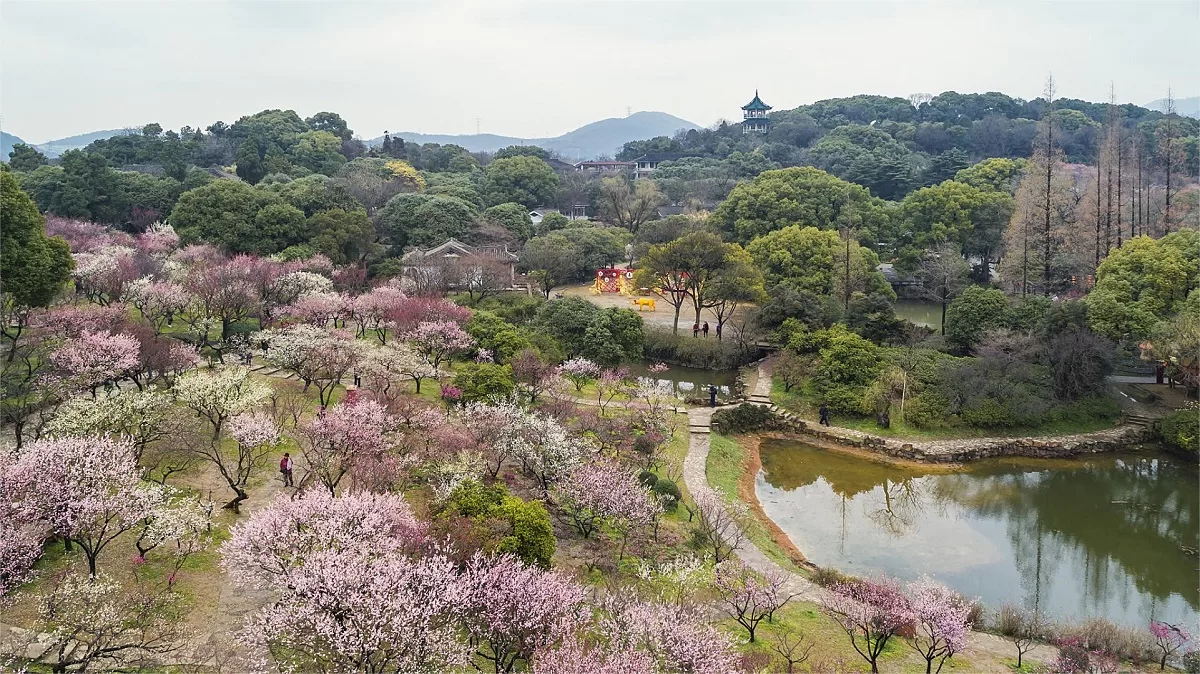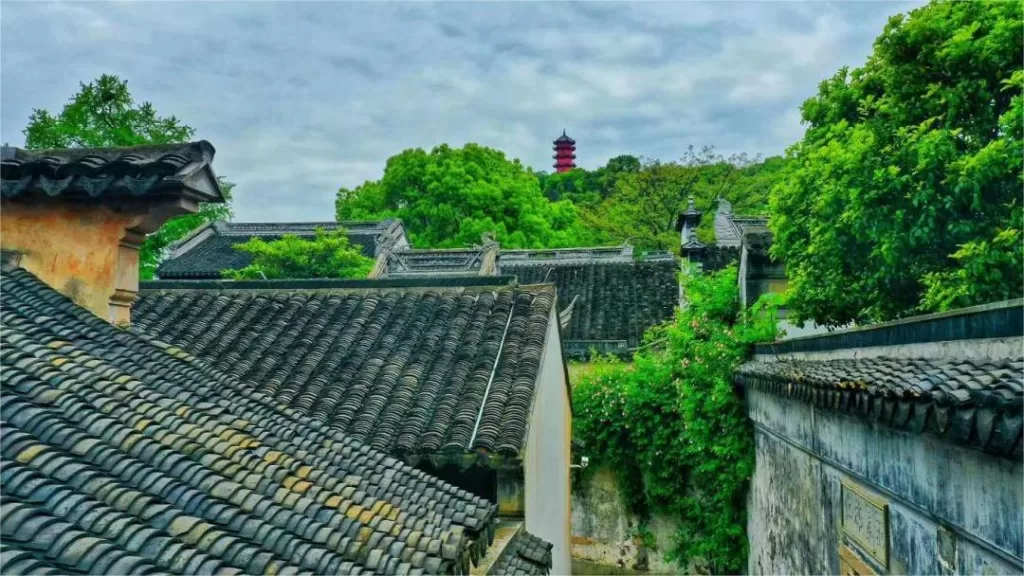Plum Garden (梅园, Meiyuan Garden), situated on the southern slopes of Dongshan and Xushan in the western outskirts of Wuxi, is a serene sanctuary known for its captivating blend of natural beauty and Chinese cultural heritage. This enchanting garden is divided into three distinct sections, each offering a unique and captivating experience.
First, the Plum Blossom Zone, dedicated to the theme of plum culture, features a mesmerizing array of plum trees that burst into a riot of colors during the blooming season. Visitors can immerse themselves in the poetic charm of these blossoms. The Ancient Plum Garden, with its traditional Chinese garden architecture and unique rock formations, provides an authentic atmosphere for relaxation and exploration. Finally, the Huaxi Zone emphasizes the natural landscapes, showcasing a harmonious blend of greenery and garden design.
Plum Garden in Wuxi is a picturesque testament to the cultural significance and natural beauty of plum blossoms, making it an ideal destination for those seeking a tranquil retreat immersed in China’s rich heritage.
Table of Contents
- Basic Information
- Location and Transportation
- Highlights of the Plum Garden
- Vlog about Plum Garden
- Useful Tips Summarized from Reviews
- Attractions near Plum Garden
Basic Information
| Website | http://www.wuximeiyuan.com/ |
| Estimated Length of Tour | 3 – 4 hours |
| Ticket Price | 60 RMB |
| Opening Hours | 7.00 – 17.00 |
| Telephone Number | 0086-0510-85511676 |
Location and Transportation
Plum Garden is conveniently located just 5 kilometers away from Wuxi’s city center, nestled between the picturesque Taihu Lake to the south and the scenic Longshan to the north. You can find it at 13 Bianjiawan, Liangxi West Road, Wuxi, Jiangsu Province, China.
For those using public transportation, there are several convenient options:
Subway: You can take Line 2 and disembark at the Meiyuan Station (Exit 5). From there, it’s a short walk to Plum Garden.
Bus: There are various bus routes that can take you to Plum Garden, including 2, 40, 52, 53, 72, 83, 87, 88, 89, 112, 131, 158, and the Express Line 3 (快3). Simply board any of these buses that head towards “梅园” (Meiyuan), and you’ll arrive at your destination.
Highlights of the Plum Garden
Xixin Spring

Xixin Spring, a significant feature within Plum Garden, was carved out in 1916 by Mr. Rong Desheng. He bestowed upon it the name “Xixin Spring,” which translates to “Cleansing the Heart Spring,” symbolizing the idea that just as objects are purified through washing, the heart can be cleansed as well. In 1983, the spring was restored, and stone tablets were placed along its banks, with the renowned plum blossom expert Professor Chen Junyu re-inscribing its name. Additionally, a stone inscription of “Xixin Spring Record,” authored by Rong Yiren during his youth, was added to the rock wall, further enriching the historical and cultural significance of this serene spring.
Kaiyuan Temple

Established in 1930 with the generous support of Mr. Rong Desheng and the guidance of Monk Liangru, Kaiyuan Temple is a renowned religious site within Plum Garden. Often referred to as Wuxi’s “Little Lingyin Temple,” it holds special significance. The temple houses three treasures: a Maitreya Buddha statue from Thailand, a temple bell from Japan, and a Bodhisattva painting from the United States. Kaiyuan Temple has a longstanding tradition of bell-ringing, attracting both local and international visitors on New Year’s Eve and New Year’s Day for the annual bell-ringing ceremony, making it a hub for celebrating the arrival of the new year.
Nianqu Pagoda

The Nianqu Pagoda stands as the crowning jewel and iconic landmark of Plum Garden. This three-tiered, 18-meter-high pagoda was constructed in 1930 in honor of their mother, Madame Shi, by the Rong brothers, Rong Zongjing and Rong Desheng. The pagoda offers a breathtaking panoramic view of the entire Plum Garden, making it a must-visit attraction. Its historical significance and commanding presence make the Nianqu Pagoda a cherished symbol of the garden, inviting visitors to ascend its heights and take in the beauty and tranquility of this remarkable destination.
Tianxin Platform

The Tianxin Platform, built in 1914, is a captivating feature within Plum Garden. It is distinguished by three towering Taihu stones in the foreground, which strikingly resemble the Chinese characters for “Fu” (福, meaning happiness), “Lu” (禄, meaning prosperity), and “Shou” (寿, meaning longevity). Consequently, this platform is often referred to as the “Three Star Stones.” This enchanting arrangement not only adds to the garden’s natural beauty but also carries a symbolic message of well-being, good fortune, and longevity, making it a delightful and culturally significant spot for visitors to explore within Plum Garden.
Huaxi Area

The Huaxi Area within Plum Garden is a picturesque landscape where the harmony of nature and human design is on full display. Here, a meandering stream follows the contours of the hills, forming cascades and water features that blend seamlessly with carefully arranged rocks and landscaping, creating a natural ecological zone that spans over 300 meters. Along the slopes, more than 100 varieties of unique flowers and plants such as ironwire lilies, alpine rhododendrons, old storksbills, sweet osmanthus, and asters flourish. The meticulously crafted artificial rock gardens further enhance the immersive experience, allowing visitors to feel as if they have stepped into a natural wonderland within Plum Garden.
Vlog about Plum Garden
Useful Tips Summarized from Reviews
Peak Blooming Season: Plum blossoms are in full bloom from February to March, with sporadic early blooms of wax plum around mid-January.
Family-Friendly Environment: Inside the Plum Garden, you’ll find extensive areas designated for family activities and outdoor dining, making it suitable for family trips.
Plum Viewing Areas: Plum blossoms are primarily distributed in five main areas: Rong’s Plum Garden, Ancient Plum and Strange Stone Nursery, both sides of Ningxiang Road, Dongheng Mountain, and the Northern Area.
- Rong’s Plum Garden:
- Featured Varieties: Silver Red, Silver Red Pavilion, Iron Bone Red.
- Blooming Period: Late January to the end of February.
- Ancient Plum and Strange Stone Nursery:
- Featured Varieties: Pink Zhu Sha, Red Dong Zhi, Double-layered Dong Zhi, etc.
- Blooming Period: Mid-January to the end of February.
- Both Sides of Ningxiang Road:
- Featured Varieties: Red Dew Plum, Peach Blossom with Human Face, Small Green Calyx, Black Field, mainly late blooming varieties.
- Blooming Period: Early February to mid-March.
- Dongheng Mountain Plum Forest:
- Featured Varieties: Xiaogongfen, Single-petal Jumping Branch, Red Beard Zhu Sha, etc.
- Blooming Period: Early February to early March.
- Northern Area Plum Forest:
- Blooming Period: Early February to mid-March.
Specialty Foods and Snacks: Enjoy local delicacies such as:
- Kaikuan Temple Blessing Vegetarian Noodles: 20 yuan per bowl.
- Along the road leading to Kaikuan Temple, you can find tofu pudding, xiaolongbao (steamed dumplings), plum blossom cake, hawthorn cake, and more.








Exploring the Plum Garden for the first time in early summer was very pleasant, as it was not crowded on a Saturday. Although there were no plum blossoms or tulips, the lush trees provided a beautiful background.